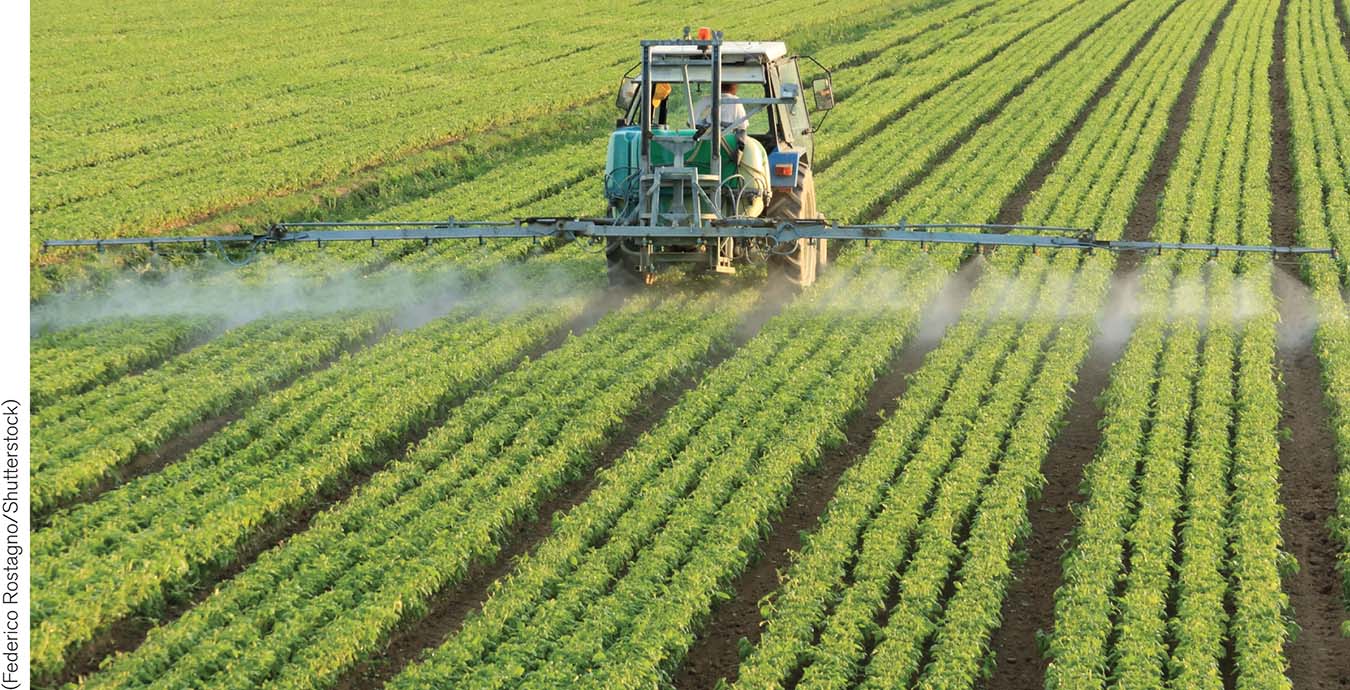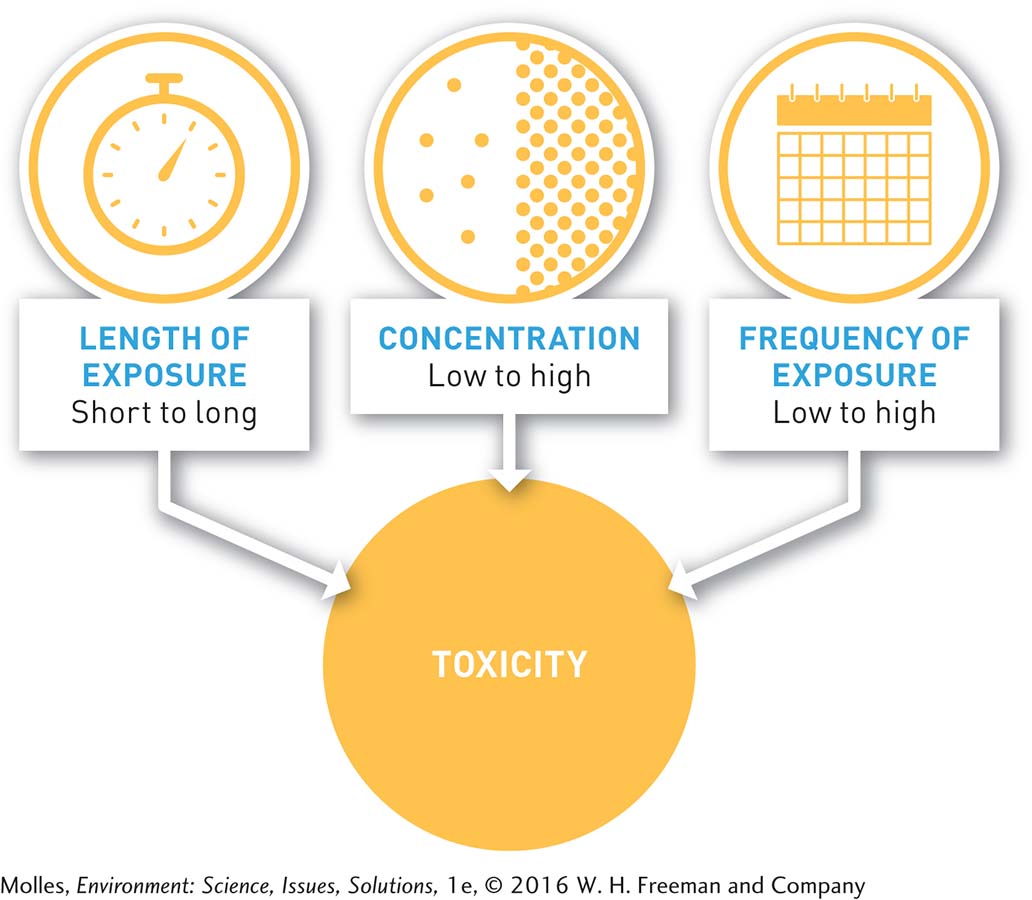11.1–11.2 Science

environmental hazards Phenomena dangerous to humans, including infectious disease, toxic substances, and pollutants.
Humans frequently encounter environmental hazards, natural and human-

11.1 Chemical hazards include toxic substances and pollutants
pollutant A substance (e.g., oil or pesticides) or condition (e.g., excessive noise) harmful to living organisms that contaminates air, water, or soil.
Toxic substances can kill you—

Natural and Manmade Toxic Substances
toxin A poisonous substance produced by a living organism (e.g., a plant, animal, fungus, or bacterium) that can harm human health. See toxicant.
toxicant A toxic substance produced by humans or as a by-
Toxic substances are generally divided into two categories: toxins and toxicants. As discussed below, a toxin is a poisonous substance produced by a living organism, such as a plant, animal, fungus, or bacterium that can harm human health. For instance, botulin, the cause of the food poisoning botulism, is a type of bacterial toxin. A toxicant is a toxic substance produced by humans or as a by-
Some toxic substances are a natural part of the environment (Figure 11.3). Arsenic, mercury, and lead are toxic substances called heavy metals. Heavy metals are found naturally in the environment and are typically not harmful in small amounts. In most cases, heavy metals become a problem to human health as a result of human actions. Mining and road construction, for example, expose fresh rock surfaces to rain that dissolves heavy metals in the rocks. Rainwater carries the heavy metals into streams and ponds and thus soaks into the ground, contaminating wells.

Humans manufacture a vast number of potentially toxic substances—
Not all chemicals are toxic, of course, but we don’t know how many of the 85,000 industrial chemicals created are indeed toxic because most of them have never been tested. Furthermore, 2,000 new chemicals are synthesized every year and very few of those are tested for toxicity before being placed in production.
toxicology The science concerned with the effects of toxic substances on humans and other organisms.
The science that studies the effects of toxic substances on humans (and other organisms) is toxicology. Three factors determine the toxic effects of a substance on humans: (1) the duration of exposure, ranging from short to long; (2) the concentration of the substance, ranging from low to high; and (3) the frequency of exposure, which can range from a single exposure to repeated exposures over time (Figure 11.4). Humans can be exposed to toxic substances by breathing them in, swallowing them in food or water, or absorbing them through the skin. The goal of toxicology is to define safe levels of exposure to toxic substances.

What are the pros and cons of requiring that the toxicity of all new chemicals be tested before they are put into production and released into the environment?

How Toxic Substances Affect the Human Body
Toxic substances, many examples of which are discussed in this section, can harm the human body in several different ways. They are generally grouped by the effects they have on the body.

How do synergistic effects complicate toxicity testing?
neurotoxins Toxic substances that attack nerve cells.
Neurotoxins attack nerve cells. Different types of neurotoxins affect nerves differently: Heavy metals kill nerve cells, whereas chemicals called organophosphates and carbamates (used in insecticides) inhibit signal transmission between nerve cells. Chlorinated hydrocarbons, which are found in some cleaning fluids, disrupt nerve cell membranes.
carcinogen A substance that causes cancer by directly damaging the DNA of cells.
Carcinogens cause cancer by directly damaging the DNA of cells. Mutations that interfere with the off signal of the cell division cycle cause cells to multiply uncontrollably, forming a tumor. Common carcinogens include chemicals such as benzene (which occurs in cigarette smoke), radioactive substances such as radon (a gas that is released by some rocks and can accumulate in basements), and heavy metals including arsenic.
teratogen A substance that causes abnormalities during embryonic growth and development, resulting in birth defects.
Teratogens cause abnormalities during embryonic growth and development, resulting in birth defects. The brain of a fetus is especially sensitive to pollutants: Exposure to lead and mercury (both heavy metals), alcohol, and insecticides can result in low IQ or neuromuscular defects that interfere with babies’ speech and movement.
allergen A substance that activates the immune system, inducing an allergic reaction.
Allergens activate the immune system, causing an allergic reaction. Allergenic effects can range from mild, such as nasal congestion from pollen, to life-
endocrine disruptor A chemical that mimics hormones, including female hormones (estrogen and progesterone), male hormones (testosterone), or thyroid hormones.
Endocrine disruptors mimic female hormones (estrogen and progesterone), male hormones (testosterone), or thyroid hormones. The results include damage to or changes in the male or female reproductive system, behavioral changes, damage to the immune system, neurological problems, and tumors.
How Toxic Substances Interact
antagonistic effect An interaction of two toxic substances wherein the toxicity of one chemical is reduced in the presence of the second chemical, which may be used as an antidote.
additive effect An interaction of two toxic substances wherein their combined toxicity is simply the sum of their individual effects.
synergistic effect An interaction of two toxic substances wherein their combined toxicity is greater than the sum of their individual effects.
Organisms are exposed to many different toxic substances at the same time, and the combined effects of two or more substances may take a variety of forms. Some chemicals have antagonistic effects. In this situation, the toxicity of a chemical is reduced in the presence of a second chemical, which may be used as an antidote. In other cases, the toxic substances may have additive effects. In this case, the toxicity of the two substances is simply the sum of their individual toxicities, for instance, 2 + 2 = 4. However, toxic substances may have synergistic effects, where their combined toxicity is greater than the sum of their individual effects; that is, instead of 2 + 2 = 4, it might be 2 + 2 = 6 or more. For example, both mercury and a toxic compound from detergents called 4-
Humans are not the only animals affected by synergistic effects of pollutants. A study of two chemicals (ethylene glycol and methanol) that are used to increase oil well production in the Gulf of Mexico found that exposure to both chemicals reduced the swimming ability of pompano (a popular game fish) much more than did exposure to either of the chemicals alone.
Think About It
Why is using sewage sludge as fertilizer on crops and pastures probably not a good idea?
What are the several types of toxic substances?
How can the antagonistic effects of one toxic substance on another be used as an antidote?